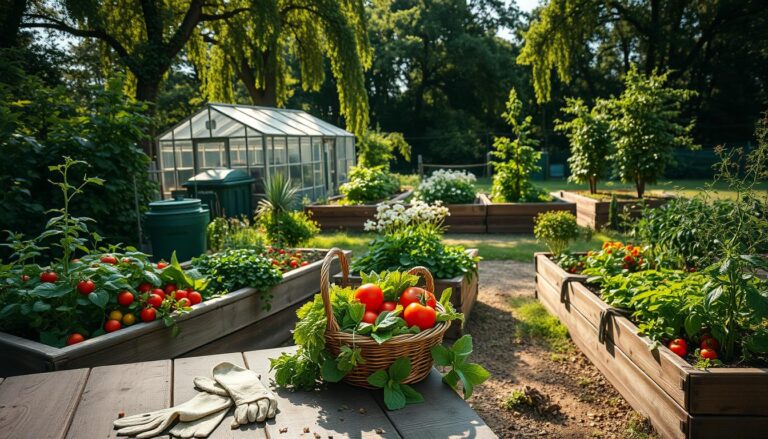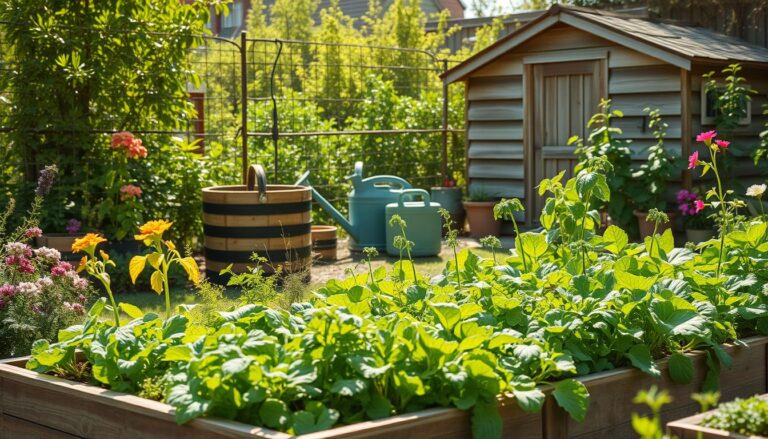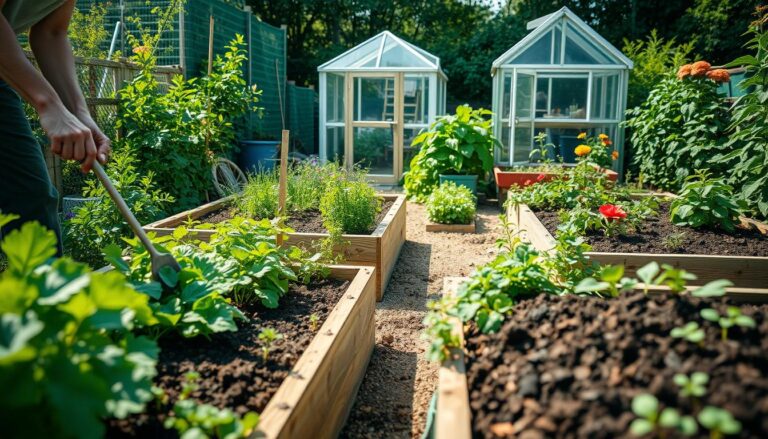Keeping your home healthy is very important. One big part of this is dealing with pests the right way. The Environmental Protection Agency (EPA) says using eco-friendly practices in pest control is key. It helps a lot in keeping our environment safe.
Choosing eco-friendly pest management helps keep your family and pets safe. It also helps protect our planet. This way, you make your home safer and help the environment at the same time.
It might seem hard to start using natural pest control methods. But, it’s actually easier than you think. Just start with small changes that can really help a lot over time.
Understanding Natural Pest Control Methods
Natural pest control uses non-toxic and eco-friendly ways to manage pests. It’s becoming more popular because it’s better for the environment and health. This is compared to chemical pest control methods.
Natural pest control methods are diverse and effective. They aim to balance ecosystems, managing pests without harming the environment or human health. Eco-friendly solutions are key, offering a safer choice for homeowners.
What Are Natural Pest Control Methods?
Natural pest control includes various techniques and strategies that avoid synthetic chemicals. It includes biological, cultural, mechanical, and chemical controls. These methods use natural substances and processes.
Examples include using beneficial insects to control pests, adopting cultural practices to deter pests, and using mechanical barriers. Natural substances can also repel or kill pests without harming the environment.
| Method | Description | Examples |
|---|---|---|
| Biological Control | Using living organisms to control pests | Ladybugs, lacewings, parasitic wasps |
| Cultural Control | Modifying practices to prevent pest infestations | Crop rotation, sanitation, pruning |
| Mechanical Control | Using physical barriers or traps | Row covers, traps, hand-picking |
| Chemical Control (Natural) | Using natural substances to control pests | Essential oils, diatomaceous earth, neem oil |
Benefits of Eco-Friendly Solutions
Eco-friendly pest control solutions have many benefits. They reduce environmental impact, improve human health, and offer a sustainable solution. By using non-toxic pest remedies, homeowners can protect their families and pets from chemicals.
These solutions also promote a balanced ecosystem. They support biodiversity and the natural balance between pests and their predators. This can lead to more effective and sustainable pest control over time.
Common Misconceptions
One common misconception is that natural pest control is less effective than chemical methods. However, research shows natural methods can be just as effective, if not more so, in the long run.
Another misconception is that natural pest control is more labor-intensive or expensive. While some methods may require more effort, they often save money and reduce maintenance over time.
Types of Natural Pest Control
Natural pest control uses eco-friendly methods that are effective. These methods include different approaches to manage pests.
Biological Control
Biological control uses living things to control pests. It’s a sustainable method that uses natural predators or parasites.
Examples of Biological Control:
- Ladybugs eat aphids and other pests.
- Lacewings feed on aphids, whiteflies, and other pests.
- Parasitic wasps target various pests.
Cultural Control
Cultural control changes gardening practices to prevent pests. It includes crop rotation, sanitation, and pruning.
Benefits of Cultural Control:
- It reduces pesticide use.
- It promotes healthy plant growth.
- It increases garden biodiversity.
Mechanical Control
Mechanical control uses physical methods to control pests. This includes hand-picking pests and using traps.
Examples of Mechanical Control:
- Sticky traps catch flying insects.
- Barriers keep pests away from plants.
- Hand-picking pests from plants.
Chemical Control
Chemical control in natural pest control uses natural substances. This includes essential oils and organic compounds.
| Method | Description | Examples |
|---|---|---|
| Biological Control | Using living organisms to control pests. | Ladybugs, Lacewings |
| Cultural Control | Modifying gardening practices. | Crop Rotation, Sanitation |
| Mechanical Control | Using physical methods to control pests. | Sticky Traps, Hand-picking |
| Chemical Control | Using natural substances to manage pests. | Essential Oils |
Using Essential Oils for Pest Management
Looking for green pest solutions? Essential oils are a great alternative to harsh chemicals. They come from plants and have been used for centuries. This makes them a safe choice for your home.
Popular Essential Oils for Repelling Pests
Some essential oils are great at keeping pests away. Peppermint oil keeps ants and spiders at bay. Lemongrass oil helps keep mosquitoes and other bugs off. Lavender, tea tree, and eucalyptus oils also have their own pest-fighting powers.
| Essential Oil | Pests Repelled |
|---|---|
| Peppermint Oil | Ants, Spiders |
| Lemongrass Oil | Mosquitoes, Flies |
| Lavender Oil | Moths, Flies |
How to Create Essential Oil Sprays
Making your own essential oil sprays is easy and saves money. Just mix 10-15 drops of your chosen oil with water in a spray bottle. Add a bit of dish soap to mix it well. Shake the bottle before each use.
- Choose your essential oil based on the type of pest you’re targeting.
- Mix the oil with water and a small amount of dish soap in a spray bottle.
- Shake well before each use.
- Spray directly on pests or areas where pests are present.
Safety Considerations
Even though essential oils are natural, they can still be risky. Always mix them with water or a carrier oil before use. Some oils can irritate skin or cause allergies. Always do a patch test first.
Keep essential oils away from kids and pets to avoid accidents. Using essential oils for pest control is a green and sustainable way to keep your home pest-free. It also makes your indoor space healthier.
Companion Planting: A Natural Approach
Companion planting uses the natural powers of plants to fight pests. It’s an old way of farming that grows different plants together. This helps them grow better, stay healthy, and be more productive.
What Is Companion Planting?
Companion planting mixes different plants to help each other. Some plants keep pests away, while others draw in good bugs or make the soil better.
Best Plants for Pest Repellence
Some plants are great at keeping pests away. For instance, marigolds fight nematodes. Lavender and mint keep moths and other pests off. Chives keep aphids away, which is good for roses and other flowers.
Tips for Successful Companion Planting
To do well with companion planting, follow these tips:
- Pick plants that work well together in terms of growth and pest resistance.
- Grow a variety of plants to keep the ecosystem balanced.
- Don’t overcrowd, as it can cause bad air and more disease.
Using companion planting as a natural pest control makes your garden healthier and greener.
Attracting Beneficial Insects
Beneficial insects are key to eco-friendly pest management. They are easy to attract and help control pests. This means you use fewer chemicals.
These insects are vital for a healthy garden. They help keep pests in check, making your garden balanced.
Why Beneficial Insects Matter
Beneficial insects, like ladybugs and lacewings, eat many pests. They protect your plants from damage and the need for harmful pesticides.
By welcoming these insects, you make your garden more sustainable. It’s better for both your garden and the environment.
Examples of Beneficial Insects
Ladybugs, lacewings, and parasitic wasps are great for gardeners. Ladybugs eat aphids, and lacewings target aphids and whiteflies.
- Ladybugs: Known for eating aphids and other soft-bodied pests.
- Lacewings: Predatory larvae feed on aphids, whiteflies, and other pests.
- Parasitic Wasps: These wasps lay their eggs inside pest insects, controlling pest populations.
Creating an Insect-Friendly Garden
To draw in beneficial insects, make your garden welcoming. Plant a variety of flowers and herbs. They provide food and shelter for these helpful insects.
Tips for Creating an Insect-Friendly Garden:
- Plant a variety of flowers that provide nectar, such as marigolds and sunflowers.
- Incorporate herbs like dill and fennel, which attract beneficial insects.
- Avoid using broad-spectrum pesticides, which can harm beneficial insects.
Homemade Pest Control Solutions
With a few common household ingredients, you can make your own non-toxic pest remedies. These are effective and safe for your family and pets.
Homemade pest control solutions can change the game for managing common pests. They are safe from harsh chemicals. These DIY solutions save money and are good for the environment.
Simple Recipes for Common Pests
Here are a few simple recipes to get you started:
- Ant Repellent: Mix equal parts water and white vinegar in a spray bottle. Spray directly on ants and around entry points.
- Fruit Fly Trap: Fill a jar with 1-2 inches of apple cider vinegar and cover the top with plastic wrap. Poke a few small holes in the plastic wrap. Fruit flies will be attracted to the vinegar and get trapped.
- Cockroach Repellent: Mix boric acid and sugar in equal parts. Sprinkle this mixture in areas where cockroaches are seen. The sugar attracts them, while the boric acid acts as a poison.
Effective Homemade Traps
Homemade traps can be highly effective for capturing and eliminating pests. Here are a few ideas:
- Sticky Traps: Coat a piece of cardboard with a sticky substance like honey or corn syrup. Place it near areas where pests are seen.
- Jar Traps: Use a jar with a bait (like apple cider vinegar or fermented fruit) and create a funnel using paper to direct pests into the jar. Cover the top with plastic wrap or a cloth to trap them inside.
When to Use DIY Solutions
DIY pest control solutions are best for small-scale infestations or as a preventative measure. If you have a severe pest problem, you might need a professional. But for minor issues, homemade solutions are quick, effective, and non-toxic.
By using these homemade pest control solutions, you can reduce your use of chemical pesticides. This makes your home safer and healthier.
Maintaining a Healthy Garden Ecosystem
Keeping your garden balanced is key to fighting pests naturally. A healthy garden can handle pests better and needs less outside help.
Soil Health and Pest Resistance
Soil health is vital for a garden’s ecosystem. Good soil helps plants grow strong, making them less vulnerable to pests. Adding organic matter and compost, and using fewer chemicals, can boost soil health. Healthy soil = healthy plants = fewer pest problems.
The Role of Native Plants
Native plants fit well in their local environment and often resist pests. Using native plants in your garden cuts down on the need for harmful chemicals. These plants have natural defenses against pests and diseases, helping your garden stay healthy.
Watering Practices to Deter Pests
Right watering is important to keep pests away. Too much water can cause diseases and attract pests. Too little water stresses plants, making them more open to pests. Finding the right balance is key. Drip irrigation and mulching help keep soil moist.
By focusing on these areas, gardeners can build a balanced ecosystem. This ecosystem is less likely to attract pests, reducing the need for harmful chemicals.
Organic Pest Control Products
The market for organic pest control products has grown. Now, people have many options to fight pests without using harsh chemicals. It’s important to know what products are out there, how to pick the best one, and how to use it right.
Overview of Available Products
There are many organic pest control products available. They include insecticidal soaps, neem oil, and pyrethrin products. Insecticidal soaps are soft on plants but work well against pests like aphids and spider mites.
Neem oil comes from neem tree seeds. It messes with insects’ hormones, stopping them from reproducing and killing them. Pyrethrin-based products are made from pyrethrum daisy flowers. They are toxic to many insects.
How to Choose the Right Product
Choosing the right organic pest control product depends on several things. You need to know the type of pest, how bad the problem is, and what your garden or home needs. Always read the product label carefully to make sure it works for your pest and is safe for pets and kids.
Think about the environment too. Pick products with little packaging and eco-friendly ingredients.
- Identify the pest correctly to choose the most effective product.
- Consider the safety of the product around pets, children, and beneficial insects.
- Look for products with environmentally friendly packaging and ingredients.
Proper Application Techniques
Using organic pest control products right is key to their success. Always follow the label instructions and protect yourself. For neem oil, mixing it with water as directed is important. Spray in the early morning or late evening to avoid harming good bugs.
By knowing the organic pest control products, picking the right one, and using it correctly, you can fight pests without chemicals.
Preventative Measures for Pest Control
Understanding the importance of preventative measures is key to sustainable pest eradication. By taking proactive steps, homeowners can greatly reduce pest infestations. This makes for a healthier living environment.
Regular Maintenance Tips
Regular maintenance is crucial in preventing pests. Keep your home clean, decluttered, and well-maintained. Regularly inspect your home for signs of pests, such as droppings or gnaw marks, and address any issues promptly.
- Keep your kitchen counters and sink area clean and dry.
- Regularly vacuum and dust, especially in areas where food is prepared or consumed.
- Take out the trash regularly and keep it in sealed bins.
Sealing Entry Points
Sealing entry points is vital in preventing pest infestations. Pests can enter your home through even the tiniest cracks and crevices. It’s essential to thoroughly inspect your home’s exterior and seal any gaps or holes.
Common entry points include around windows, doors, vents, and pipes. Use caulk or steel wool to seal these areas effectively.
Proper Food Storage Solutions
Proper food storage is another crucial aspect of pest prevention. Store food in airtight containers and keep them in sealed cupboards or on high shelves. This helps to deter pests that are attracted to food, such as rodents and insects.
| Preventative Measure | Description | Benefit |
|---|---|---|
| Regular Maintenance | Keeping your home clean and well-maintained | Reduces pest hiding spots and food sources |
| Sealing Entry Points | Sealing cracks and crevices around your home | Prevents pests from entering your home |
| Proper Food Storage | Storing food in airtight containers | Deter pests attracted to food |
Seasonal Pest Control Strategies
Knowing when pests are most active is key to using green pest solutions. Each season has its own pest problems. So, we need different plans to keep them under control.
Spring: Preparing for Pests
Spring is when pest problems start. To get ready, clean up any mess around your house. This makes it less inviting to pests. Also, fix any holes or gaps and make sure doors and windows are closed tight.
Summer: Battling Summer Invaders
Summer brings pests like mosquitoes, ants, and flies. Using essential oils and natural repellents can help keep them away. Also, keep your yard clean and get rid of any standing water to avoid infestations.
| Season | Common Pests | Prevention Strategies |
|---|---|---|
| Spring | Rodents, Termites | Seal entry points, Clean debris |
| Summer | Mosquitoes, Ants, Flies | Use natural repellents, Remove standing water |
| Fall & Winter | Cockroaches, Spiders | Seal cracks, Reduce humidity |
Fall and Winter: Closing Off Your Home
When it gets colder, pests like cockroaches and spiders look for warm places inside. To stop them, seal any holes and lower the humidity. Natural deterrents like diatomaceous earth can also help keep pests out.
By using these seasonal pest control strategies, you can manage pests all year. This makes your home safer and healthier.
Resources for Natural Pest Control
If you want to learn more about eco-friendly pest management, there are many resources out there. You can find detailed guides and join online forums. These tools will help you keep your home pest-free.
Books and Guides
There are many books and guides that dive deep into natural pest control. They cover everything from the basics to advanced techniques. These resources are great for learning more about eco-friendly pest management.
Online Communities
Online forums and communities are perfect for sharing experiences and asking questions. They connect people who use natural pest control methods. It’s a great place to learn from others.
Local Workshops and Events
Attending local workshops and events is a great way to learn by doing. You can meet experts and learn about the latest in eco-friendly pest management. It’s a hands-on way to improve your skills.
FAQ
What are some effective natural pest control methods for my home?
Are natural pest control methods as effective as chemical-based solutions?
How can I use essential oils for pest control?
What is companion planting, and how can it help with pest control?
How can I attract beneficial insects to my garden?
Are homemade pest control solutions effective?
What are some preventative measures I can take to avoid pest infestations?
How can I maintain a healthy garden ecosystem to prevent pest issues?
What are some eco-friendly pest control products available?
How can I choose the right organic pest control product for my needs?

Sortemdia nasceu com o propósito de trazer alegria e oportunidades para todos por meio de sorteios gratuitos de prêmios incríveis. O site tem como missão oferecer experiências acessíveis, divertidas e justas para quem deseja concorrer a produtos, serviços e brindes sem pagar nada por isso. Acreditamos que a sorte pode bater à porta de qualquer pessoa — e no Sortemdia, ela pode chegar com apenas um clique.



